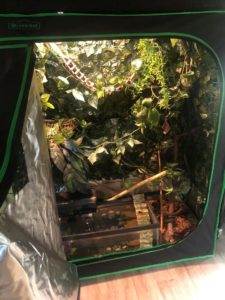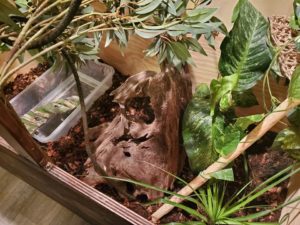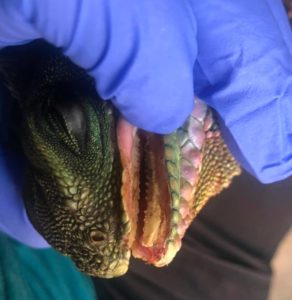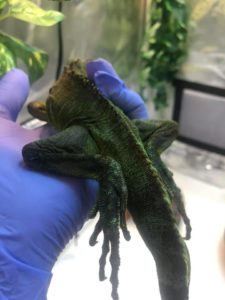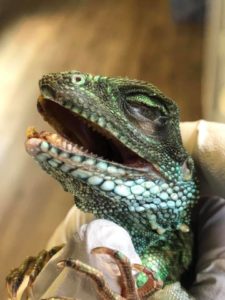CHINESE WATER DRAGON
Species name: Physignathus cocincinus
Lifespan: 15-20 years
Origin: Indonesia and New Guinea
Adult size: 18-24”
Caging
We recommend at least a 4’ x 2’ x 5’ enclosure for one Chinese water dragon. They should always be housed singly. For larger males or more active individuals, taller or wider enclosures are preferred, such as 4’x4’x7’. Cages can be purchased online, home built, or modified from existing materials. A grow tent, designed for horticulture, is actually a great and inexpensive enclosure for a water dragon. These grow tents keep humidity high, provide a lot of space, and have soft sides without glass to prevent nose rub. Chinese water dragons do not understand glass and are prone to nose injuries from trying to run through it. If you choose a PVC or wood enclosure, limit the amount of glass used to prevent injury. For babies, you can start them out in a smaller grow tent (such as a 2’ x 2’ x 4’), or a 40-55 gallon glass aquarium with 3 sides covered with paper. If you use an aquarium for a baby, you must cover part of the screen top and mist frequently to keep humidity high. A glass aquarium is never an appropriate enclosure for an adult water dragon.
Decor
Chinese water dragons need a lot of decor to climb on, bask on, and hide in. We use a mixture of live and fake plants, artificial vines (Fluker’s Bend-A-Branch), hammocks, cork bark, and branches. It can take a lot of decor to fill up a large enclosure. If you are using any branches from outdoors, use hardwood branches only and sanitize them beforehand by baking in the oven or bleaching.
Substrate
Substrates must hold humidity well. It is not recommended to use just coconut coir (Eco Earth) alone, as Chinese water dragons are prone to getting this in their eyes and developing eye infections. We use organic topsoil and occasionally mix this with ReptiChip, coconut coir, cypress mulch, Reptisoil, or sphagnum moss. This species is a good candidate for a bioactive enclosure if you provide the correct drainage layer and substrate depth, which can be difficult with a grow tent.
Humidity
Chinese water dragons need high humidity levels to survive and thrive. 65-80% is ideal. If your water dragon has flaky scales or is having trouble shedding, increase humidity.
Heating
Chinese water dragons should have at least one basking area of about 90-95°F. The ambient temperatures in the enclosure should be around 78-80°F. A warm, humid environment is easy to obtain with a grow tent, but an enclosure with a screen top will need modification to keep the correct temperatures. A night time temperature drop is recommended, so no additional heat lamps are needed at night unless the temperature drops below 75°F. If it does, we recommend using a ceramic heat emitter.
Lighting
A UVB light is necessary in addition to the basking light. Chinese water dragons need a strong UVB light; the small coil bulbs are insufficient for this species. They need a long, linear light of at least 22”, and UVB percentage should be 10%. We prefer using T5HO lights, but if your basking spot is very close to your UVB bulb, use a T8 bulb instead. Remember to change out your UVB bulbs every 6-12 months depending on brand.
Diet
Chinese water dragons are mostly insectivorous. While some water dragons will also eat occasional greens, this is not a large part of their wild diets. We do not recommend feeding fruit, as water dragons are prone to dental disease and the sugars from fruit can exacerbate this. It is always best to feed a varied diet with many different species of insects.
We mainly feed dubia roaches, but also offer crickets, superworms, hornworms, black soldier fly larvae, and silkworms. Some water dragons will also eat fish such as frozen silversides or tilapia strips. We do not recommend feeding live fish unless the source is known, as they can introduce parasites to your water dragon. Avoid minnows and goldfish as they can lead to vitamin B1 deficiencies. Water dragons are also prone to obesity so pinkie mice should be avoided.
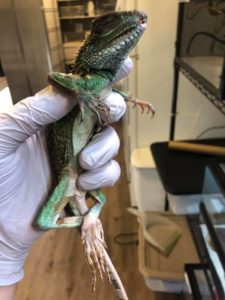
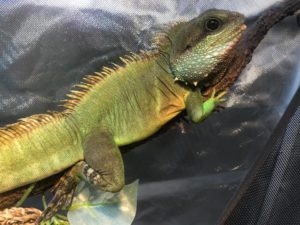
Supplementation
Use calcium with D3 1-2 times a week and a multivitamin every 1-2 weeks.
Water
We recommend providing at least 10-20 gallons of swimming space depending on the size of your dragon. You can use a large water pan, such as a plastic storage tub or cat litter pan, but this must be emptied daily as water dragons are prone to defecating in their water. We prefer to use an aquarium and strong filter with regular water changes. We provide a heater in the aquarium set at 80°F.
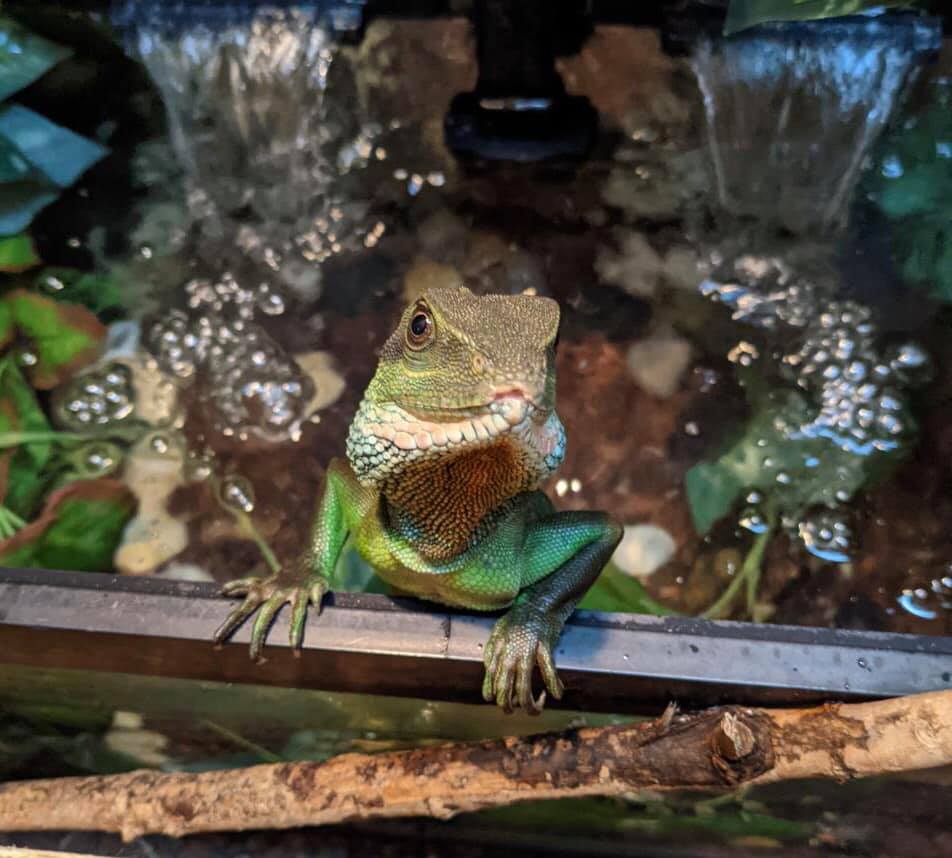
Things You Should NOT Do
Use aspen, pine, or cedar shavings: We don’t recommend wood shavings in general as they easily mold when in a higher-humidity setup. Pine or cedar should never be used due to toxic phenols in the wood.
Use a red heat lamp: Reptiles CAN see red light and this will disturb their sleeping cycles. If you need additional heat at night, use a ceramic heat emitter.
Use a heat rock: While many pet stores will try to sell you a heat rock, they are extremely dangerous. Do not use them for any animal. Heat rocks are not well regulated and can reach temperatures high enough to severely burn your animal.
Cohabitate: Chinese water dragons are not social animals and should never be housed with another dragon. They can, and often will, show aggression towards each other, including nipping toes and tails. This can lead to severe injuries and infections. Chinese water dragons should always be housed singly.
House in a Tank: Chinese water dragons are prone to nose rub, which can develop into severe mouth and bone infections. No tank is tall enough for a Chinese water dragon, as they need preferably around 6’ of height.
Common Health Issues
Burns: Burns are possible when the basking lights are too close to the basking spot. Make sure that your bulb has the correct wattage and always check the temperature with a good thermometer or infrared temperature gun. Do not use the stick-on thermometers, as they are inaccurate and will only measure the temperature on the glass side. Use a temperature gun or digital thermometer with a probe to measure the basking spot directly. If your dragon does suffer a burn, seek veterinary attention immediately to assess the severity of the burn and treat it properly.
Dental Disease: Water dragons are prone to dental disease, which is often caused by a high fruit diet or made worse by a mouth infection. To prevent dental disease, feed a varied insect diet, limited fruit or sugars, and reduce the amount of glass in the enclosure. See your veterinarian if your water dragon’s gum lines are receding or if the teeth are discolored or rotting.
Mouth Rot: Mouth rot, or ulcerative stomatitis, is a condition where the mouth develops a bacterial infection. This can be due to a dirty water source or dirty enclosure, a wound in the mouth or nose rub that becomes infected, or stuck shed around the face. Mouth rot can quickly become serious, as it is painful and will cause the dragon to not want to eat. We have seen cases where this infection progresses to teeth and bone, requiring extensive surgery and treatment. You should see a veterinarian, who will clean out the mouth with topical antiseptics and start an antibiotic regimen.
Obesity: Chinese water dragons are a leaner species and should not be chunky or chubby. Obesity can be quite serious in reptiles as it can lead to liver issues such as hepatic lipidosis. If your water dragon is overweight, eliminate fruit in the diet and offer lower-fat insects, such as dubia roaches and crickets.
Prolapse: Cloacal prolapses can happen in both male and female dragons, but male dragons can also have hemipenal prolapses. A prolapse is an emergency that should see a veterinarian immediately. If it is recent, sometimes the vet can push the prolapsed tissue back in and place a temporary suture, but advanced prolapses can become infected and necrotic. Some will require amputation. Prolapses can be caused by dehydration, fecal impaction, extreme parasite infestations, or can be from no noticeable cause.
Metabolic Bone Disease: MBD, also known as nutritional secondary hyperparathyroidism, is common in Chinese water dragons who are not provided with calcium and/or a UVB light. Signs of MBD include curved limbs, kinks in the spine or tail, lethargy, or paralysis in the hind limbs. Water dragons will also develop limb fractures more commonly, as a fall in a tall enclosure with MBD will often break bones. To prevent MBD, provide a varied diet, use a strong linear UVB light, and offer supplemental calcium with D3 twice weekly. If your lizard is showing signs of MBD, see a veterinarian to assess the severity and start treatment. This may include prescription- strength liquid calcium and dietary correction. MBD can be fatal if untreated.
Dysecdysis/Retained Shed: This is very common with Chinese water dragons, as they are often kept in low humidity enclosures. Stuck shed can accumulate around the toes, tail, and dorsal spikes, and cause them to become necrotic and fall off. It can also cause secondary bacterial infections, so stuck shed can quickly become serious if not removed and treated.
Eye Infections: These are often caused when water dragons are kept in low-humidity enclosures. When substrate dries out, it can get into the eyes and cause irritation and secondary infections. Eye infections can also be caused by unclean environments or water dishes. Coconut coir is also not recommended as a sole substrate, as it can lead to eye infections. Be sure to maintain a clean environment and fresh water for your dragon.
Nose Rub: This is a wound or abrasion on the nose or chin that is caused by running into glass. If you notice a red, bloody, or scabbed area on the nose, switch your dragon to a no-glass enclosure such as a grow tent. Make sure to keep the area clean to prevent infection. We recommend washing the wound with dilute chlorhexidine or betadine, then applying silver sulfadiazine cream or triple antibiotic ointment. If the wound worsens, see your veterinarian for treating a potential infection.
Parasites: Chinese water dragons can carry many different types of parasites, including pinworms, coccidia, spirochetes, and protozoans. This is VERY common in Chinese water dragons, as almost all of them sold in pet stores and at reptile expos are wild caught. We do not advise purchasing a wild-caught reptile, as they are more likely to have health issues and are unsocialized and more difficult to tame. Always try to purchase a healthy water dragon from a reputable breeder, or find a rescue that can perform a fecal on any rescued dragons. It is common for reptiles to have a small level of parasites, this is normal for their gut flora. However, when a reptile is sick or stressed, the parasites can take over and cause diarrhea, weight loss, regurgitation, and anorexia. This can become serious, so bring a fecal to your veterinarian if your dragon is exhibiting the above signs.
Respiratory Infection: Chinese water dragons can develop respiratory infections due to incorrect temperatures, humidity, or unclean conditions. Signs include open mouth breathing, wheezing, sneezing, and discharge from the mouth or nostrils. Respiratory infections may be caused by bacteria, fungi, or viruses, but the most common are likely bacterial and these are usually treatable. Make sure to identify and rectify the husbandry conditions that may have contributed to the infection, and go to the veterinarian for antibiotics. In our experience, most cases will respond to a course of ceftazidime or a similar antibiotic, but some are caused by more resistant bacteria that can be identified and treated with a tracheal wash, culture, and sensitivity. Fungal and viral infections are typically more rare and do not have as effective treatments.
Scale Rot/Dermatitis: Chinese water dragons housed in enclosures that are too wet or not cleaned properly can get infections called scale rot or dermatitis. Your substrate should never be dripping wet or grow mold. Additionally, always make sure your dragon has plenty of branches and hammocks to rest on above the substrate. Remove feces immediately and completely change substrate every 2-3 months, unless it is a fully functioning bioactive. Signs of scale rot include blisters, ulcers, or scabs on the ventral area. Mild cases can usually be treated by placing the dragon in a sterile paper towel setup, soaking in dilute chlorhexidine or betadine, and applying topical SSD cream or triple antibiotic ointment. However, we always recommend seeing a veterinarian to assess severity, as more severe cases may require wound debridement or systemic antibiotics.
SOURCES
https://www.petmd.com/reptile/species/chinese-water-dragon

